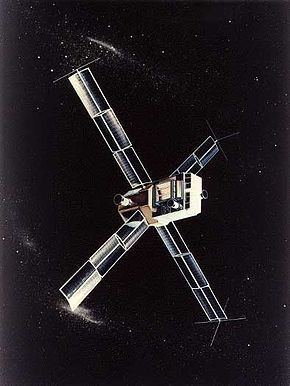Mission type Astronomy COSPAR ID 1975-037A Mission duration 4 years Inclination 3.0033° Period 1.6 hours Launch site Broglio Space Centre | SATCAT no. 07788 Launch date 7 May 1975 Inclination 3.0033° Launch mass 196.7 kg | |
 | ||
Similar Small Astronomy Satellite 2, Uhuru, High Energy Astronom, Hakucho, High Energy Astronom | ||
The Small Astronomy Satellite 3 (SAS 3, also known as SAS-C before launch) was a NASA X-ray astronomy space telescope. It functioned from May 7, 1975 to April 1979. It covered the X-ray range with four experiments on board. The satellite, built by the Johns Hopkins University Applied Physics Laboratory (APL), was proposed and operated by MIT's Center for Space Research (CSR). It was launched on a Scout vehicle from the Italian San Marco launch platform near Mombasa, Kenya, into a low-Earth, nearly equatorial orbit. It was also known as Explorer 53, as part of NASA's Explorer program.
Contents
The spacecraft was 3-axis stabilized with a momentum wheel that was used to establish stability about the nominal rotation, or z-axis. The orientation of the z-axis could be altered over a period of hours using magnetic torque coils that interacted with the Earth's magnetic field. Solar panels charged batteries during the daylight portion of each orbit, so that SAS 3 had essentially no expendables to limit its lifetime beyond the life of the tape recorders, batteries, and orbital drag. The spacecraft typically operated in a rotating mode, spinning at one revolution per 95-min orbit, so that the LEDs, tube and slat collimator experiments, which looked out along the y-axis, could view and scan the sky almost continuously. The rotation could also be stopped, allowing extended (up to 30 min) pointed observations of selected sources by the y-axis instruments. Data were recorded on board by magnetic tape recorders, and played back during station passes every orbit.
SAS 3 was commanded from the NASA Goddard Space Flight Center (GSFC) in Greenbelt MD, but data were transmitted by modem to MIT for scientific analysis, where scientific and technical staff were on-duty 24 hours a day. The data from each orbit were subjected to quick-look scientific analysis at MIT before the next orbital station pass, so the science operational plan could be altered by telephoned instruction from MIT to GSFC in order to study targets in near real-time.
Objectives
The major scientific objectives of the mission were:
- Determine bright X-ray source locations to an accuracy of 15 arcseconds
- Study selected sources over the energy range 0.1-55 keV
- Continuously search the sky for X-ray novae, flares, and other transient phenomena
Instrumentation
SAS 3 carried four experiments:
- Rotating Modulation Collimator (RMC) Experiment, which observed along the rotation (Z) axis of the spacecraft, covering the 2–11 keV energy range, and providing high-precision locations of X-ray sources to an accuracy of up ~15 arcseconds.
- Slat collimated proportional counter instrument, covering 1–60 keV, looking out perpendicular to the spacecraft Z-axis, and providing coarse positions of unknown and transient sources.
- Tube collimated proportional counter instrument, also covering 1–60 keV and also looking out perpendicular to the spacecraft Z-axis, for detailed study of the spectral behavior and time-variability of sources observed during pointed or dithered observations.
- Low-Energy Detector (LED) system, covering 0.1-1 keV with a 2.9° FOV along the y-axis.
Research results
SAS 3 was especially productive due to its flexibility and rapid responsiveness. Among its most important results were:
Lead investigators on SAS 3 were MIT professors George W. Clark, Hale V. Bradt, and Walter H. G. Lewin. Other major contributors were Profs Claude Canizares and Saul A. Rappaport, and Drs Jeffrey A. Hoffman, George Ricker, Jeff McClintock, Rodger E. Doxsey, Garrett Jernigan, John Doty, and many others, including numerous graduate students.
